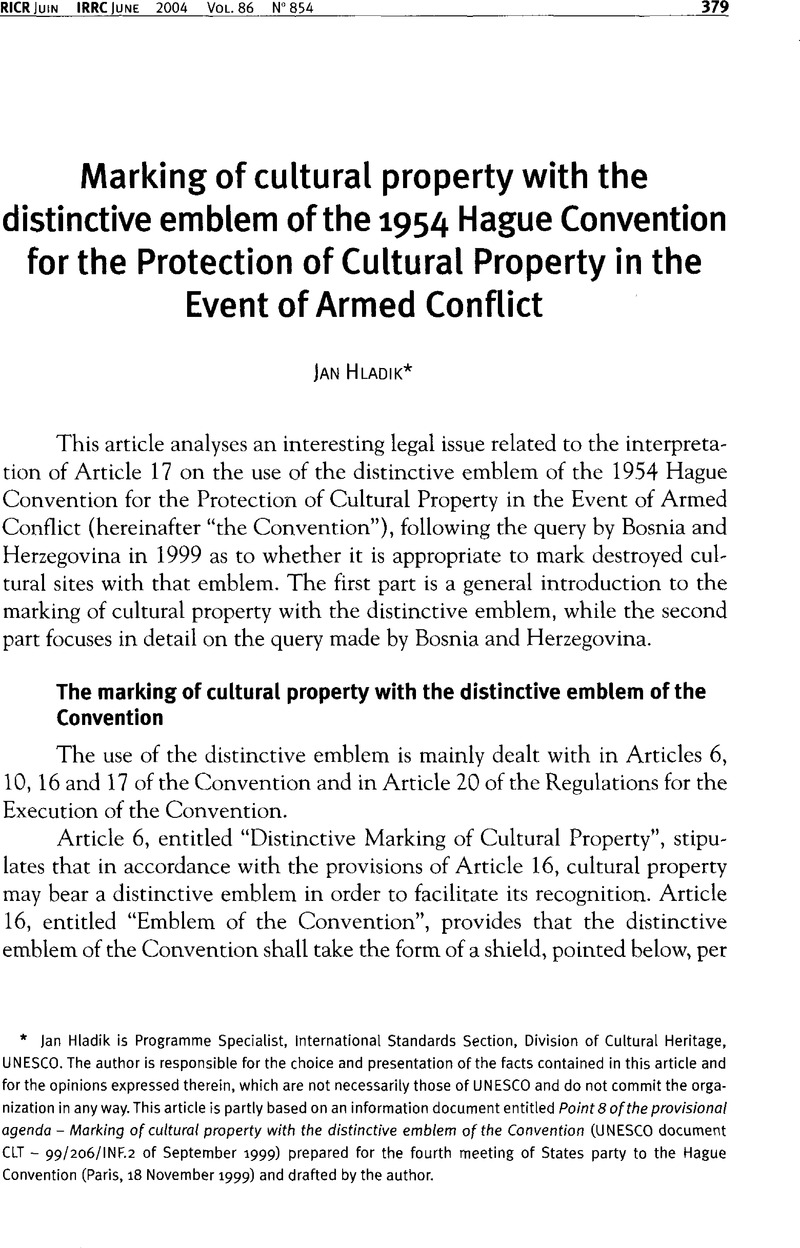Published online by Cambridge University Press: 27 April 2010

1 Records on the Conference convened by the United Nations Educational, Scientific and Cultural Organization held at the Hague from 21 April to 14 May 1954, Staatsdrukkerij-en uitgeverijbedrijf, The Hague, 1961, p. 383Google Scholar.
2 Ibid., p. 312.
3 Ibid., p. 384.
4 Ibid., p. 312.
5 Toman, Jiri, The Protection of Cultural Property in the Event of Armed Conflict (Commentary on the Convention of Cultural Property in the Event of Armed Conflict and its Protocol, signed on 14 May 1954 in The Hague, and on other instruments of international humanitarian law concerning such protection), Dartmouth Publishing Company Limited/UNESCO, Hants/Paris, 1996, p. 187Google Scholar.
6 Information on the Implementation of the Convention for the Protection of Cultural Property in the Event of Armed Conflict, The Hague 1954, 1995 Reports, UNESCO document, Ref. CLT-95/WS/13, Paris, December 1995. For more about the reporting under the Convention, see the author's article, “Reporting system under the 1954 Convention for the Protection of Cultural Property in the Event of Armed Conflict”, Revue Internationale de la Croix-Rouge/International Review of the Red Cross, Vol. 82, No. 840, December 2000, pp. 1001–1016CrossRefGoogle Scholar.
7 Ibid., second document, p. 1006.
8 Ibid., first document, pp. 24–25, 44 and 48, respectively.
9 Ibid., first document), p. 23.
10 Article 85(4)(d) of Protocol I (Protocol Additional to the Geneva Conventions of 12 August 1949, and Relating to the Protection of Victims of International Armed Conflicts), on the “Repression of breaches of this Protocol”, stipulates the following: “4. In addition to the grave breaches defined in the preceding paragraphs and in the Conventions, the following shall be regarded as grave breaches of this Protocol, when committed wilfully and in violation of the Conventions or the Protocol: (…) (d) making the clearly-recognized historic monuments, works of art or places of worship which constitute the cultural or spiritual heritage of peoples and to which special protection has been given by special arrangement, for example, within the framework of a competent international organization, the object of attack, causing as a result extensive destruction thereof, where there is no evidence of the violation by the adverse Party of Article 53, sub-paragraph (b), and when such historic monuments, works of art and places of worship are not located in the immediate proximity of military objectives”.
11 The report is still in the draft form and will be distributed as soon as it has been translated into Arabic, Chinese, French, Russian and Spanish.
12 Article 27(2) of the Convention, entitled “Meetings”, reads as follows: “2. Without prejudice to any other functions which have been conferred on it by the present Convention or the Regulations for its execution, the purpose of the meeting will be to study problems concerning the application of the Convention and of the Regulations for its execution, and to formulate recommendations in respect thereof.” To date, five meetings of States party to the Convention have taken place, in 1962, 1995, 1997, 1999 and 2001.
13 Information document Point 8 of the provisional agenda – Marking of cultural property with the distinctive emblem of the Convention (UNESCO document CLT – 99/206/INF.2 of September 1999).
14 Article X(2) reads as follows: “2. The General Assembly authorizes the United Nations Educational, Scientific and Cultural Organization to request advisory opinions of the International Court of Justice on legal questions arising within the scope of its activities, other than questions concerning the mutual relationship of the Organization and the United Nations or other specialized agencies.” Basic Texts, 2004 edition, UNESCO, Paris, 2004, p. 177Google ScholarPubMed.
15 Ibid., p. 177.